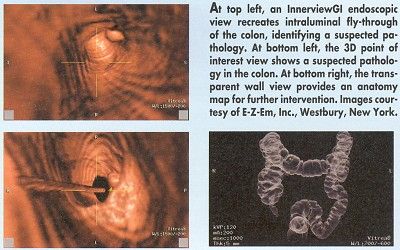InnerviewGI Workstation for Virtual Colonoscopy
WESTBURY, New York-E-Z-Em, Inc. has begun marketing its InnerviewGI workstation for virtual colonoscopy procedures. The product is able to render three-dimensional (3D) images in just seconds and provides imaging professionals with multiple 3D view options (see figures below), as well as synchronized 2D and 3D views of the colon, the company said in a news release. InnerviewGI is powered by Vital Images’ Vitrea 2 software and features real-time navigation of 3D volume data.
WESTBURY, New YorkE-Z-Em, Inc. has begun marketing its InnerviewGI workstation for virtual colonoscopy procedures. The product is able to render three-dimensional (3D) images in just seconds and provides imaging professionals with multiple 3D view options (see figures below), as well as synchronized 2D and 3D views of the colon, the company said in a news release. InnerviewGI is powered by Vital Images’ Vitrea 2 software and features real-time navigation of 3D volume data.

E-Z-Em also recently introduced PROTOCOL2L, its new colon insufflation system for virtual colonoscopy imaging procedures. The system consists of an automated insufflation device and disposable administration sets. The product uses carbon dioxide instead of room air to distend the colon for accurate imaging diagnosis and patient comfort. As an automated system, gas pressure is regulated and constant, minimizing the pressure spikes that can occur during manual insufflation, the company said.
Newsletter
Stay up to date on recent advances in the multidisciplinary approach to cancer.